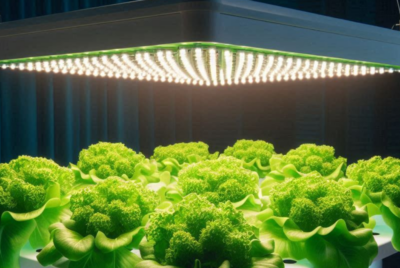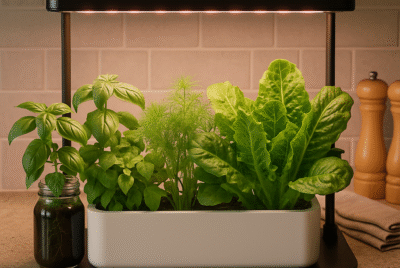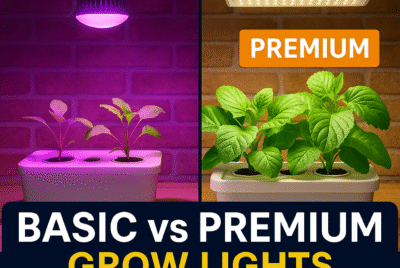How to Grow Hydroponic Strawberries: A Comprehensive Guide
Strawberries are one of the most popular fruits in the world. Strawberries are also perfect for gardening and offer several benefits, including higher yields, fewer pests and diseases, and faster growth rates. In this guide, I will show you how to grow hydroponic strawberries successfully, even if you have no prior experience in hydroponic gardening.
Why grow hydroponic strawberries?
Growing strawberries has several advantages over traditional soil-based gardening. Here are a few reasons why you should consider growing hydroponic strawberries:
- Higher Yields:Hydroponic strawberries can produce up to three times more fruit per plant than soil-grown strawberries.
- Faster Growth Rates:Hydroponic strawberries can grow up to 30% faster than soil-grown strawberries.
- More Nutritious:Hydroponic strawberries are typically more nutrient-dense than soil-grown strawberries.
- Less Water Usage:Hydroponic gardening uses up to 90% less water than traditional soil-based gardening.
- Fewer Pests and Diseases:Hydroponic gardening is less susceptible to pests and diseases, which means fewer chemicals are needed to protect the plants.
Choosing the Right Hydroponics kit for Strawberries
Choosing the right hydroponic system is essential for growing healthy and productive hydroponic strawberries. There are several types of hydroponics kits to choose from, including:
- Deep Water Culture (DWC) kit: DWC is a simple hydroponics kit that uses a nutrient-rich water solution and an air stone to provide oxygen to the roots.
- Nutrient Film Technique (NFT) System: NFT is a popular hydroponics kit that uses a thin film of nutrient-rich water to feed the plants.
- Ebb and Flow System: Ebb and flow is a hydroponics kit that floods the roots with nutrient-rich water for a set period before draining the water back to the reservoir.
- Drip kits: Drip is a hydroponics kit that uses a drip emitter to feed the plants with nutrient-rich water.
For strawberries, I recommend using a DWC kit or an NFT kit. These systems are simple to set up, easy to maintain, and provide optimal growing conditions for strawberries. Consider a greenhouse setting or simply grow small scale on your kitchen space.
Choosing the Right Strawberry Varieties for Hydroponics
Choosing the right strawberry variety is critical for successful hydroponic strawberry growing.
Growing strawberries hydroponically brings a sense of joy and accomplishment as you witness these succulent berries thrive in a nutrient-rich water-based environment. With each variety offering its unique flavors and characteristics, I am thrilled to provide you with detailed information to help you choose the perfect hydroponic strawberries for your indoor garden.
Factors to Consider When Choosing Hydroponic Strawberry Varieties
Selecting the right hydroponic strawberry varieties is a critical first step. As you embark on this flavorful adventure, keep in mind the growth habits, space requirements, and light preferences of each variety to ensure they flourish in your hydroponic system. Understanding the flavors you desire, whether you prefer a sweet, tangy, or perfectly balanced taste, will guide you in selecting the most delectable choices for your hydroponic garden.
Top 10 Hydroponic Strawberry Varieties: A Symphony of Flavors
1. Honeoye – The Hydroponic Pioneer
- Light Requirements: Honeoye thrives in bright, indirect light, making it an ideal choice for well-lit indoor hydroponic setups.
- Temperature: This early-season variety prefers intermediate to warm temperatures, providing the perfect conditions for steady growth.
- Watering: Keep the nutrient solution consistently moist, allowing the top layer to dry slightly between watering sessions.
- Humidity: Honeoye enjoys moderate to high humidity levels, ensuring optimal growth and fruit development.
- Air Circulation: Provide good air circulation to prevent fungal issues and promote healthy strawberry growth.
- Unique Hydroponics Care Tip: After fruiting, provide a short rest period with reduced watering to encourage vigorous new growth.
2. Chandler – The Classic Hydroponic Charm
- Light Requirements: Chandler thrives in moderate to bright, indirect light, providing the ideal environment for strong, healthy plants.
- Temperature: This classic variety is well-suited to intermediate to warm temperatures, ensuring productive growth.
- Watering: Keep the nutrient solution consistently moist to prevent stress and promote continuous fruit production.
- Humidity: Chandler enjoys moderate to high humidity levels, fostering a lush and vibrant hydroponic strawberry patch.
- Air Circulation: Ensure good air circulation to prevent mold and mildew, enhancing the overall health of your plants.
- Unique Hydroponics Care Tip: Regularly trim runners to focus the plant’s energy on fruit production, resulting in larger and sweeter berries.
3. Albion – The Everbearer for Hydroponics
- Light Requirements: Albion prefers moderate to bright, indirect light, ensuring healthy growth and bountiful yields.
- Temperature: This everbearer variety thrives in intermediate to warm temperatures, offering extended harvesting opportunities.
- Watering: Maintain consistent moisture levels in the nutrient solution to keep your Albion strawberries thriving.
- Humidity: Albion appreciates moderate to high humidity levels, contributing to the overall success of your hydroponic garden.
- Air Circulation: Provide adequate air circulation to prevent moisture-related issues and promote healthy fruiting.
- Unique Hydroponics Care Tip: As an everbearer, Albion may require regular pruning to encourage new flower and fruit development.
4. Seascape – The Hydroponic All-Star
- Light Requirements: Seascape performs best in moderate to bright, indirect light, optimizing its fruiting potential.
- Temperature: This day-neutral variety flourishes in intermediate to warm temperatures, ensuring a consistent supply of strawberries.
- Watering: Maintain consistent moisture levels to support optimal nutrient uptake and vibrant fruiting.
- Humidity: Seascape thrives in moderate to high humidity levels, fostering healthy foliage and fruit growth.
Air Circulation: Provide adequate air circulation to prevent disease and promote robust hydroponic strawberry plants.
Unique Hydroponics Care Tip: To encourage fruiting, gently shake the plants or use a small fan to simulate pollination.
5. Jewel – The Prolific Hydroponic Producer
- Light Requirements: Jewel prefers moderate to bright, indirect light, providing an energetic boost for vigorous growth.
- Temperature: This prolific variety is well-suited to intermediate to warm temperatures, ensuring an abundance of juicy berries.
- Watering: Maintain consistent moisture levels in the nutrient solution, ensuring Jewel’s continuous productivity.
- Humidity: Jewel enjoys moderate to high humidity levels, contributing to its overall health and fruiting prowess.
- Air Circulation: Provide good air circulation to promote healthy foliage and prevent common hydroponic issues.
- Unique Hydroponics Care Tip: As a prolific producer, Jewel may benefit from additional support structures to hold the weight of its fruit.
6. Fort Laramie – The Hydroponic Cold Climate Champion
- Light Requirements: Fort Laramie thrives in moderate to bright, indirect light, even in cooler indoor hydroponic settings.
- Temperature: This resilient variety excels in intermediate to cooler temperatures, making it an excellent choice for colder climates.
- Watering: Keep the nutrient solution consistently moist to support Fort Laramie’s steady and productive growth.
- Humidity: Fort Laramie appreciates moderate to high humidity levels, enhancing its growth and fruiting potential.
- Air Circulation: Ensure good air circulation to prevent moisture-related issues and maintain a healthy hydroponic strawberry crop.
- Unique Hydroponics Care Tip: Fort Laramie’s cold hardiness allows it to flourish in colder conditions, but ensure proper insulation during frosty periods.
7. Sweet Charlie – The Hydroponic Southern Sensation
- Light Requirements: Sweet Charlie thrives in moderate to bright, indirect light, soaking up the sun’s energy for optimal growth.
- Temperature: This Southern sensation is well-suited to intermediate to warm temperatures, flourishing in warmer climates.
- Watering: Maintain consistent moisture levels in the nutrient solution, ensuring Sweet Charlie’s sweet and succulent berries.
- Humidity: Sweet Charlie appreciates moderate to high humidity levels, adding to the vibrancy of its hydroponic fruiting.
- Air Circulation: Provide good air circulation to prevent humidity-related issues and maintain a healthy hydroponic strawberry patch.
- Unique Hydroponics Care Tip: Regularly inspect and clean your hydroponic system to prevent algae buildup and ensure nutrient delivery.
8. Earliglow – The Hydroponic Time-Honored Favorite
- Light Requirements: Earliglow prefers moderate to bright, indirect light, allowing its early-season berries to flourish.
- Temperature: This time-honored favorite performs well in intermediate to warm temperatures, delivering sweet and juicy strawberries.
- Watering: Keep the nutrient solution consistently moist, ensuring Earliglow’s rapid growth and continuous fruiting.
- Humidity: Earliglow enjoys moderate to high humidity levels, supporting its overall health and robust hydroponic growth.
- Air Circulation: Provide good air circulation to prevent humidity-related issues and promote lush foliage.
- Unique Hydroponics Care Tip: Early-season strawberries like Earliglow benefit from supplementary lighting to extend daylight hours.
9. Allstar – The Hydroponic Disease-Resistant Wonder
- Light Requirements: Allstar flourishes in moderate to bright, indirect light, providing the perfect conditions for strong plants.
- Temperature: This disease-resistant wonder excels in intermediate to warm temperatures, promising a successful hydroponic harvest.
- Watering: Maintain consistent moisture levels in the nutrient solution to ensure Allstar’s disease-resistant qualities.
- Humidity: Allstar appreciates moderate to high humidity levels, fostering its overall health and fruiting success.
- Air Circulation: Provide good air circulation to prevent humidity-related issues and maintain healthy hydroponic strawberry plants.
- Unique Hydroponics Care Tip: Regularly monitor pH and nutrient levels to ensure the best results from Allstar’s disease-resistant traits.
10. Tristar – The Flavorful Hydroponic Finale
- Light Requirements: Tristar thrives in moderate to bright, indirect light, ensuring its flavorful finale of berries.
- Temperature: This day-neutral variety performs best in intermediate to warm temperatures, producing an array of delectable strawberries.
- Watering: Keep the nutrient solution consistently moist to support Tristar’s continuous fruiting potential.
- Humidity: Tristar enjoys moderate to high humidity levels, contributing to its overall health and fruit development.
- Air Circulation: Provide adequate air circulation to prevent humidity-related issues and promote healthy fruiting.
- Unique Hydroponics Care Tip: For day-neutral varieties like Tristar, ensure even light distribution to optimize fruiting throughout the season.
Grape selection that works for you
With the captivating symphony of the “Top 10 Hydroponic Strawberry Varieties,” your hydroponic garden will be brimming with delicious delights. Each variety brings its unique flair and charm to the stage, promising a fruitful journey for any hydroponic gardener. Embrace the joy of nurturing these sweet gems, and savor the harvest of nature’s most delightful strawberries.
Among the popular hydroponic strawberry varieties, “Chandler” stands out as one of the most commonly grown choices. Its adaptability, sweet flavor, and consistent performance make it a favorite among hydroponic growers. Chandler’s ability to thrive in various growing conditions and produce delectable strawberries makes it a top pick for hydroponic gardeners. With its outstanding qualities and widespread cultivation, Chandler remains a popular and reliable choice for hydroponic strawberry growers worldwide.
Maintaining the Hydroponic System
Maintaining the hydroponic system is crucial for the growth and health of your strawberry plants. Here are some tips to keep your hydroponic system in good condition:
- Regularly check the pH levels of the nutrient solution and adjust as needed. The optimal pH range for hydroponic strawberries is between 5.5 and 6.5.
- Check the nutrient solution strength and adjust as needed. It is recommended to change the nutrient solution every two to three weeks.
- Monitor the water level in the reservoir and add water as needed to maintain the appropriate level.
- Inspect the system for any clogs, leaks, or damage, and fix any issues promptly.
Harvesting the Strawberries
Once your strawberries are fully grown, it’s time to harvest them. Harvesting can be done when the fruit is red and ripe. Simply twist the fruit off the stem and collect it in a basket or container.
It is important to note that hydroponic strawberries tend to have a shorter shelf life than traditional field-grown strawberries. It is recommended to consume them within a few days of harvesting.
Conclusion
Growing strawberries is a fun and rewarding experience that offers many benefits, such as increased yields, reduced water usage, and a shorter growing time. By following the steps outlined in this guide, you can successfully grow your own hydroponic strawberries and enjoy the sweet, juicy fruit all year round.
Remember to choose the right system, select healthy plants, provide the appropriate growing conditions, and maintain the system regularly. With a little patience and dedication, you can harvest a bountiful crop of delicious strawberries that are a sustainable and cost effective way of producing food for your home.
FAQs:
1. Are hydroponic strawberries as nutritious as field-grown strawberries?
Yes, hydroponic strawberries are just as nutritious as field-grown strawberries. In fact, hydroponic systems can provide even better control over nutrient levels, resulting in healthier plants.
2. Do hydroponic strawberries taste different from field-grown strawberries?
No, hydroponic strawberries taste just as sweet and delicious as field-grown strawberries. The growing method does not affect the taste of the fruit.
3. Can I grow hydroponic strawberries indoors?
Yes, they can be grown indoors as long as they have access to adequate light, either from a natural source or artificial grow lights.
4. How often should I check the pH levels of the nutrient solution?
It is recommended to check the pH levels of the nutrient solution daily and adjust as needed.
5. How long does it take for hydroponic strawberries to grow?
Hydroponic strawberries typically take around 60-90 days to grow, depending on the variety and growing conditions.
*We may earn a commission from purchases made through our links, at no cost to you. This does not affect our product recommendations. Please see our disclosure to learn more.




